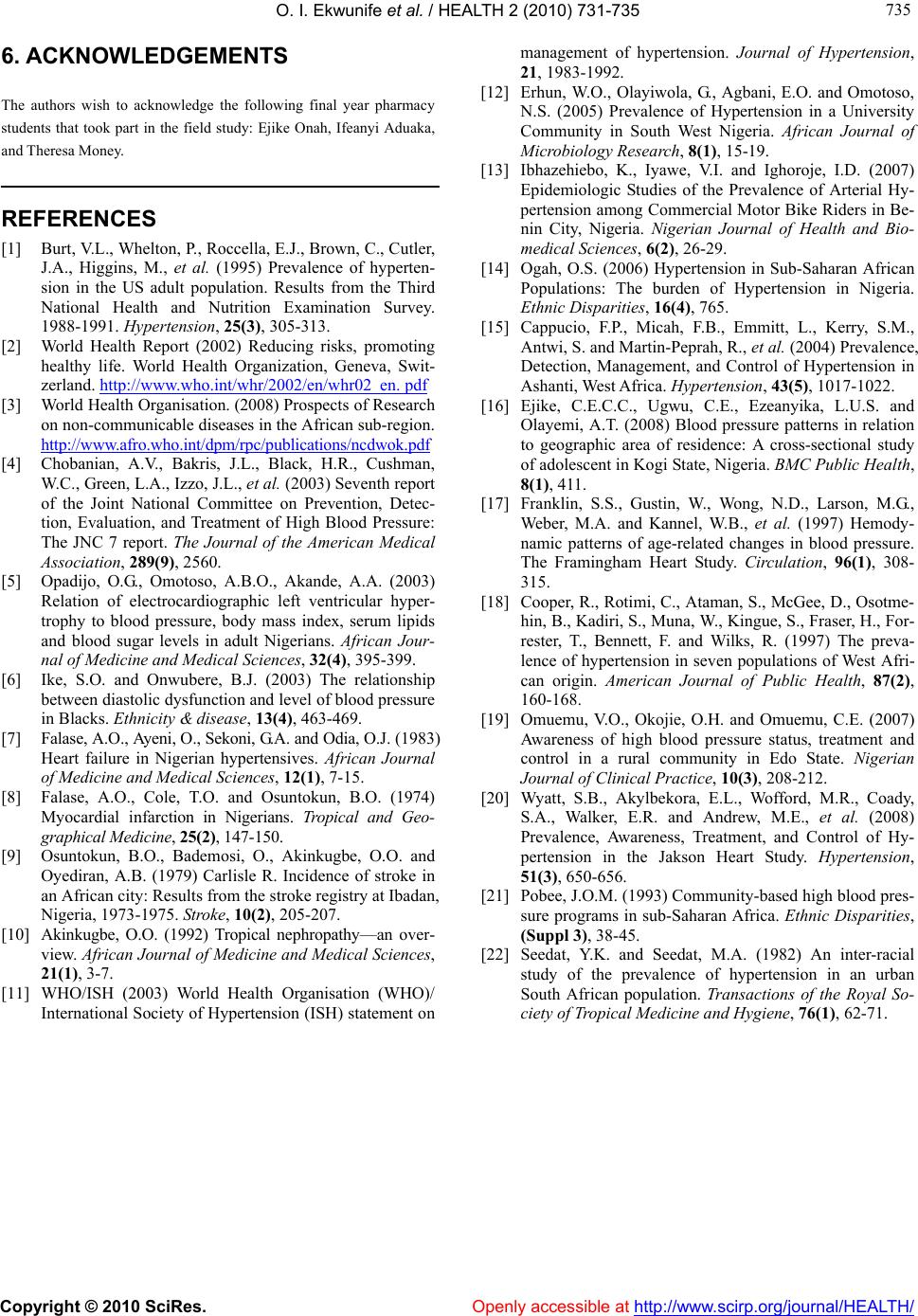
O. I. Ekwunife et al. / HEALTH 2 (2010) 731-735
Copyright © 2010 SciRes. Openly accessible at http://www.scirp.org/journal/HEALTH/
735
735
6. ACKNOWLEDGEMENTS
The authors wish to acknowledge the following final year pharmacy
students that took part in the field study: Ejike Onah, Ifeanyi Aduaka,
and Theresa Money.
REFERENCES
[1] Burt, V.L., Whelton, P., Roccella, E.J., Brown, C., Cutler,
J.A., Higgins, M., et al. (1995) Prevalence of hyperten-
sion in the US adult population. Results from the Third
National Health and Nutrition Examination Survey.
1988-1991. Hypertension, 25(3), 305-313.
[2] World Health Report (2002) Reducing risks, promoting
healthy life. World Health Organization, Geneva, Swit-
zerland. http://www.who.int/whr/2002/en/whr02_en. pdf
[3] World Health Organisation. (2008) Prospects of Research
on non-communicable diseases in the African sub-region.
http://www.afro.who.int/dpm/rpc/publications/ncdwok.pdf
[4] Chobanian, A.V., Bakris, J.L., Black, H.R., Cushman,
W.C., Green, L.A., Izzo, J.L., et al. (2003) Seventh report
of the Joint National Committee on Prevention, Detec-
tion, Evaluation, and Treatment of High Blood Pressure:
The JNC 7 report. The Journal of the American Medical
Association, 289(9), 2560.
[5] Opadijo, O.G., Omotoso, A.B.O., Akande, A.A. (2003)
Relation of electrocardiographic left ventricular hyper-
trophy to blood pressure, body mass index, serum lipids
and blood sugar levels in adult Nigerians. African Jour-
nal of Medicine and Medical Sciences, 32(4), 395-399.
[6] Ike, S.O. and Onwubere, B.J. (2003) The relationship
between diastolic dysfunction and level of blood pressure
in Blacks. Ethnicity & disease, 13(4), 463-469.
[7] Falase, A.O., Ayeni, O., Sekoni, G.A. and Odia, O.J. (1983)
Heart failure in Nigerian hypertensives. African Journal
of Medicine and Medical Sciences, 12(1), 7-15.
[8] Falase, A.O., Cole, T.O. and Osuntokun, B.O. (1974)
Myocardial infarction in Nigerians. Tropical and Geo-
graphical Medicine, 25(2), 147-150.
[9] Osuntokun, B.O., Bademosi, O., Akinkugbe, O.O. and
Oyediran, A.B. (1979) Carlisle R. Incidence of stroke in
an African city: Results from the stroke registry at Ibadan,
Nigeria, 1973-1975. St ro k e , 10(2), 205-207.
[10] Akinkugbe, O.O. (1992) Tropical nephropathy—an over-
view. African Journal of Medicine and Medical Sciences,
21(1), 3-7.
[11] WHO/ISH (2003) World Health Organisation (WHO)/
International Society of Hypertension (ISH) statement on
management of hypertension. Journal of Hypertension,
21, 1983-1992.
[12] Erhun, W.O., Olayiwola, G., Agbani, E.O. and Omotoso,
N.S. (2005) Prevalence of Hypertension in a University
Community in South West Nigeria. African Journal of
Microbiology Research, 8(1), 15-19.
[13] Ibhazehiebo, K., Iyawe, V.I. and Ighoroje, I.D. (2007)
Epidemiologic Studies of the Prevalence of Arterial Hy-
pertension among Commercial Motor Bike Riders in Be-
nin City, Nigeria. Nigerian Journal of Health and Bio-
medical Sciences, 6(2), 26-29.
[14] Ogah, O.S. (2006) Hypertension in Sub-Saharan African
Populations: The burden of Hypertension in Nigeria.
Ethnic Disparities, 16(4), 765.
[15] Cappucio, F.P., Micah, F.B., Emmitt, L., Kerry, S.M.,
Antwi, S. and Martin-Peprah, R., et al. (2004) Prevalence,
Detection, Management, and Control of Hypertension in
Ashanti, West Africa. Hypertension, 43(5), 1017-1022.
[16] Ejike, C.E.C.C., Ugwu, C.E., Ezeanyika, L.U.S. and
Olayemi, A.T. (2008) Blood pressure patterns in relation
to geographic area of residence: A cross-sectional study
of adolescent in Kogi State, Nigeria. BMC Public Health,
8(1), 411.
[17] Franklin, S.S., Gustin, W., Wong, N.D., Larson, M.G.,
Weber, M.A. and Kannel, W.B., et al. (1997) Hemody-
namic patterns of age-related changes in blood pressure.
The Framingham Heart Study. Circulation, 96(1), 308-
315.
[18] Cooper, R., Rotimi, C., Ataman, S., McGee, D., Osotme-
hin, B., Kadiri, S., Muna, W., Kingue, S., Fraser, H., For-
rester, T., Bennett, F. and Wilks, R. (1997) The preva-
lence of hypertension in seven populations of West Afri-
can origin. American Journal of Public Health, 87(2),
160-168.
[19] Omuemu, V.O., Okojie, O.H. and Omuemu, C.E. (2007)
Awareness of high blood pressure status, treatment and
control in a rural community in Edo State. Nigerian
Journal of Clinical Practice, 10(3), 208-212.
[20] Wyatt, S.B., Akylbekora, E.L., Wofford, M.R., Coady,
S.A., Walker, E.R. and Andrew, M.E., et al. (2008)
Prevalence, Awareness, Treatment, and Control of Hy-
pertension in the Jakson Heart Study. Hypertension,
51(3), 650-656.
[21] Pobee, J.O.M. (1993) Community-based high blood pres-
sure programs in sub-Saharan Africa. Ethnic Disparities,
(Suppl 3), 38-45.
[22] Seedat, Y.K. and Seedat, M.A. (1982) An inter-racial
study of the prevalence of hypertension in an urban
South African population. Transactions of the Royal So-
ciety of Tropical Medicine and Hygiene, 76(1), 62-71.